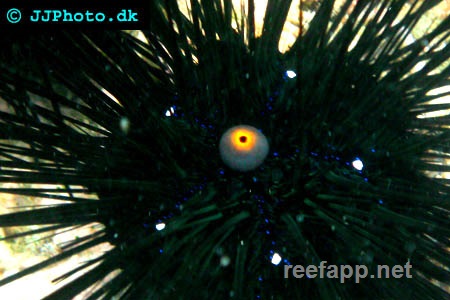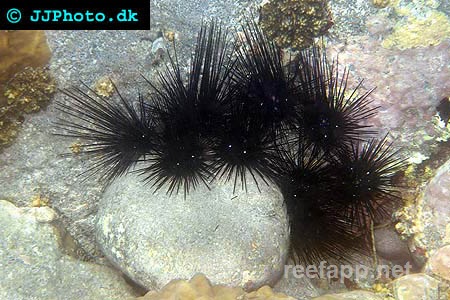Diadema setosum
| Latin name | Diadema setosum |
|---|---|
| Local name | Long-spined sea urchin |
| Family | Echinoidea - Diadema |
| Origin | East Indian Ocean, Australia, Indonesia, East Pacific, Central/West Pacific |
| Max length | 60 cm (23.6") |
| Minimum volume |
200 l (53 gal) |
|---|---|
| Hardiness |
Average |
| Suitable for aquarium |
Suitable for most aquarium |
| Reef safe |
Always reef safe |
| Aggressiveness | Peaceful |
| Recommended |
Macroalgea (Eg. seaweed / nori) Microalgea (Eg. spirulina) |
|---|
This species will overturn pieces of corals and corals which are not fully attached.
This species can eat large amounts of algae (relative to their size) from rocks, like green hair algae and filamentous algae.
As it doesn’t eat every algae type, in case of a specific algae plague, find out more precise information.
Sea urchins are often used to keep various algae at bay.
They are very effective algae eaters, and will eat anything from coralline algae to green hair algae.
Sea urchins must not be kept in an aquarium with few algae, as they may starve to death.
Sea urchins should be acclimatized slowly, due to sensitivity towards changes in salinity.
Diadema setosum - Wikipedia - (English)
Ronald L. Shimek. 2004. Marine Invertebrates (PocketExpert Guide) - TFH Publications / Microcosm Ltd. - (English)
Ronald L. Shimek. 2003. Sea Urchins, A Testy Subject - Reefkeeping Magazine - (English)
Bob Fenner. Some Spines Now! Sea Urchins (and Sand Dollars), the Echinoids, Pt. 1, Pt. 2 - Wet Web Media - (English)




